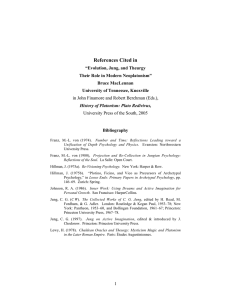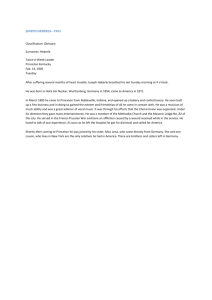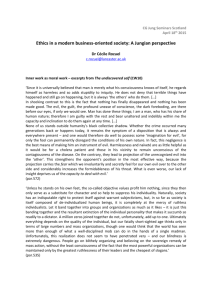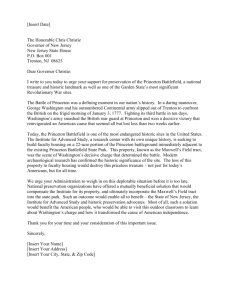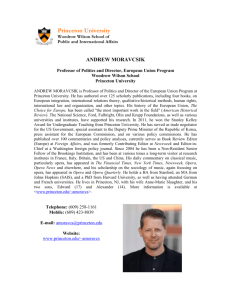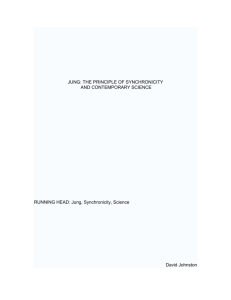Jung and the East - The Astro Home Page
advertisement
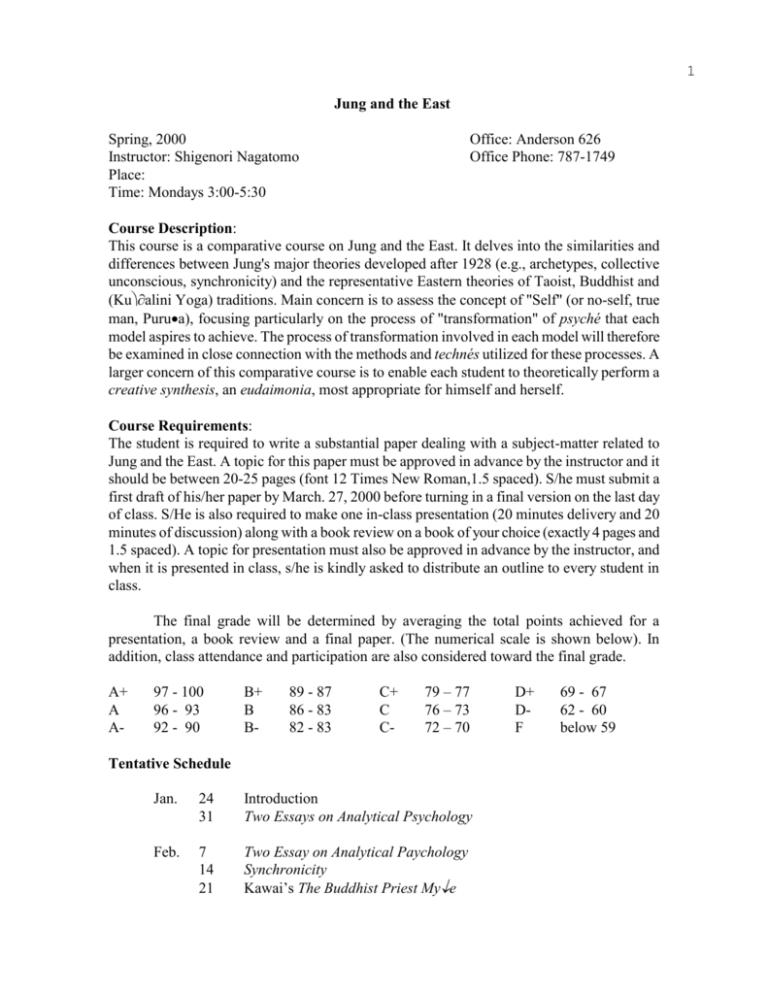
1 Jung and the East Spring, 2000 Instructor: Shigenori Nagatomo Place: Time: Mondays 3:00-5:30 Office: Anderson 626 Office Phone: 787-1749 Course Description: This course is a comparative course on Jung and the East. It delves into the similarities and differences between Jung's major theories developed after 1928 (e.g., archetypes, collective unconscious, synchronicity) and the representative Eastern theories of Taoist, Buddhist and (Kualini Yoga) traditions. Main concern is to assess the concept of "Self" (or no-self, true man, Purua), focusing particularly on the process of "transformation" of psyché that each model aspires to achieve. The process of transformation involved in each model will therefore be examined in close connection with the methods and technés utilized for these processes. A larger concern of this comparative course is to enable each student to theoretically perform a creative synthesis, an eudaimonia, most appropriate for himself and herself. Course Requirements: The student is required to write a substantial paper dealing with a subject-matter related to Jung and the East. A topic for this paper must be approved in advance by the instructor and it should be between 20-25 pages (font 12 Times New Roman,1.5 spaced). S/he must submit a first draft of his/her paper by March. 27, 2000 before turning in a final version on the last day of class. S/He is also required to make one in-class presentation (20 minutes delivery and 20 minutes of discussion) along with a book review on a book of your choice (exactly 4 pages and 1.5 spaced). A topic for presentation must also be approved in advance by the instructor, and when it is presented in class, s/he is kindly asked to distribute an outline to every student in class. The final grade will be determined by averaging the total points achieved for a presentation, a book review and a final paper. (The numerical scale is shown below). In addition, class attendance and participation are also considered toward the final grade. A+ A A- 97 - 100 96 - 93 92 - 90 B+ B B- 89 - 87 86 - 83 82 - 83 C+ C C- 79 – 77 76 – 73 72 – 70 Tentative Schedule Jan. 24 31 Introduction Two Essays on Analytical Psychology Feb. 7 14 21 Two Essay on Analytical Paychology Synchronicity Kawai’s The Buddhist Priest Mye D+ DF 69 - 67 62 - 60 below 59 2 Mar. 28 ditto 13 20 27 The Secret of the Golden Flower ditto Kakuan’s Ten Ox-herding Pictures and Abe’s Article April 3 10 17 24 Jung's Commentary on "Kundalini Yoga." (Motoyama’s the Awakening of the Cakras. Amidhayudhyanisutra Class Presentation Class Presentation Required Texts: *Amidhayudhyanisutra. Masao Abe, "The Self in Jung and Zen," in Eastern Buddhist, pp. 50-70, Vol. XVIII, No. 1, 1985. C.G. Jung, Two Essays on Analytical Psychology, (Princeton, N.J.: Princeton University Press, 1972). ________, Psychology and the East, (Princeton, N.J.: Princeton University Press, 1978). ________, Synchronicity, (Princeton, N.J.: Princeton University Press, 1973). ________, his commentary on "Kualini Yoga." *Hayao Kawai, The Buddhist Priest Mye (Venice, Calif: The Lapis Press, 1992). Richard Wilhelm, tr., The Secret of the Golden Flower, (New York: Harcourt Brace Jovanovich, 1962). Suggested Readings: C.G.Jung, The Archetypes and the Collective Unconscious, (Princeton, N.J.: Princeton University Press, 1980). _________, Memories, Dreams, Reflections, (New York: Vintage Books, 1963). ________, Four Archetypes, (Princeton, N.J.: Princeton University Press, 1973). ________, Mandala Symbolism, (Princeton, N.J.: Princeton University Press, 1973). ________, Symbols of Transformation, (Princeton, N.J.: Princeton University Press, 1973). 3 J.J. Clarke, Jung and Eastern Thought (New York: Routledge, 1994). June Singer, Boundaries of the Soul (New York: Anchor Books, 1973). Hiroshi Motoyama, tr. Shigenori Nagatomo and Clifford Ames, Toward Superconsciousness: Meditational Theory and Practice: Calif.: Asian Humanities Press, 1990). _______________, tr. Pamela Winfield and Shigenori Nagatomo, The Awakening of the Cakras and Emancipation (Unpublished Mss.). J. Marvin Spiegelman & Mokusen Miyuki, Buddhism and Jungian Psychology, (Phoenix, Arizona: Falcon Press, 1987). Jean Shinoda Bolen, The Tao of Psychology: Synchronicity and the Self, (San Francisco, Harper & Row, 1979). Jolande Jacobi, The Way of Individuation, (Grand Rapids, Iowa (?): William b. Eerdmans Publishing Co., 1976). *Kakuan,"Ten Oxherding Pictures" Robert H. Hopcke, A Guided Tour of the Collected Works of C.G. Jung, (Boston, Shambala, 1992). Roger Brooke, Jung and Phenomenology, (New York: Routledge, 1991). W.Y. Evans-Wentz, ed., The Tibetan Book of the Great Liberation, (New York: Oxford University Press, 1982).
